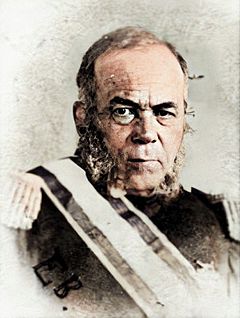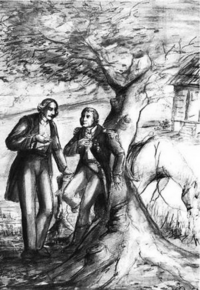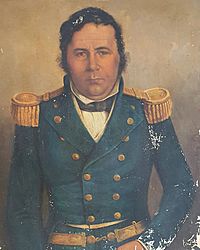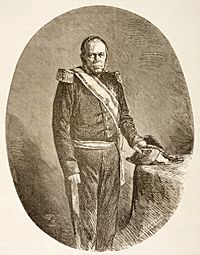Pedro Santana facts for kids
Quick facts for kids
Pedro Santana
|
|
|---|---|

Colour portrait of Pedro Santana
|
|
| In office November 14, 1844 – August 4, 1848 |
|
| Vice President | None |
| Preceded by | Francisco del Rosario Sánchez |
| Succeeded by | Council of Secretaries of State |
| In office May 30, 1849 – September 23, 1849 |
|
| Preceded by | Manuel Jimenes |
| Succeeded by | Buenaventura Báez |
| In office February 15, 1853 – May 26, 1856 |
|
| Vice President | Felipe Benicio Alfau Bustamante (1853) Manuel de Regla Mota (1853-1856) |
| Preceded by | Buenaventura Báez |
| Succeeded by | Manuel de Regla Mota |
| In office August 31, 1858 – March 18, 1861 |
|
| Vice President | Benigno Filomeno de Rojas (1858-1861) |
| Preceded by | José Desiderio Valverde |
| Succeeded by | Annexation to Spain |
| Governor-General of Santo Domingo | |
| In office March 18, 1861 – July 20, 1862 |
|
| Preceded by | Himself as President |
| Succeeded by | Felipe Ribero |
| Personal details | |
| Born | June 29, 1801 Hincha, Santo Domingo (now Hinche, Haiti) |
| Died | June 14, 1864 (aged 62) Santo Domingo, Santo Domingo (now Santo Domingo, Dominican Republic) |
| Nationality | Dominican, Spanish |
| Spouses |
|
| Relations | Octavio Antonio Beras Rojas (great-great-grandnephew) |
| Residences | Hato de El Prado, El Seibo Province |
| Military service | |
| Allegiance | |
| Branch/service | |
| Rank | |
| Battles/wars | Dominican War of Independence Dominican Restoration War |
Pedro Santana y Familias (born June 29, 1801 – died June 14, 1864) was an important military leader and politician from the Dominican Republic. He was the first President of the Dominican Republic. He was also known as the "Libertador de la Patria," which means "Liberator of the Homeland."
Santana was a strong supporter of the Dominican fight against Haitian rule. He was a key general during the Dominican War of Independence (1844–1856). Unlike many others who wanted a fully independent Dominican state, Santana believed the country would be safer if it rejoined the Spanish Empire. He helped bring the area back under Spanish control. He also exiled or imprisoned some people who had fought for independence alongside him. Santana had to resign from his position due to growing opposition. He passed away during the Dominican Restoration War, which led to the country becoming independent again.
Contents
Early Life and Family Background
Pedro Santana was born on June 29, 1801, in Hincha, a city that was then part of the Spanish colony of Santo Domingo. Today, Hincha is in Haiti. His mother, Petronila Familias, was of Spanish Canarian background. His father, Pedro Santana, was also likely of Canarian descent. Both of his parents owned land near the border between Spanish Santo Domingo and French Saint Domingue.
After the Haitian Revolution in 1804, the Santana family moved to the Cibao valley. They later fled to El Seibo in the eastern part of the country. This move happened to escape violence against white people on the island. The family became involved in cattle ranching. In El Seibo, Pedro's father famously cut off the head of French governor Jean-Louis Ferrand during the Battle of Palo Hincado. He took it as a trophy to Santo Domingo.
Santana's Role in Politics and Military

Pedro Santana served as the president of the Dominican Republic several times. He was president from 1844 to 1848, 1853 to 1856, and 1858 to 1861. In 1861, the Dominican Republic was annexed by Spain, just as Santana had wanted. After this, Santana became the Governor-General of the territory. He held this title until 1862.
Santana was a very skilled military leader. However, he often ruled like a dictator. While some historians criticize his economic policies, he was careful in managing public affairs. He was also a great soldier.
Santana also played a key role in the Revolution of July 7, 1857. During this time, the Cibao region placed their revolutionary army under his command. The Congress of the Dominican Republic honored Santana. On July 18, 1849, they gave him the title of "Liberator of the Nation." This was for his victory in the Battle of Las Carreras. In this battle, Santana led 800 Dominican troops to defeat 10,000 Haitian soldiers led by Faustin Soulouque.
Santana's Leadership Style
Many people see Santana as a brilliant military strategist. He was crucial in helping the Dominican Republic gain independence from Haiti. However, some historians believe that his later actions prevented him from being a true national hero.
- Actions Against Independence Supporters: After driving the Haitian army out, Santana quickly moved against the very people who fought for independence with him. Santana believed the new nation could not survive without being annexed by Spain. The "Trinitarian Independentists" did not agree with this idea.
- Exiling La Trinitaria Members: Santana arrested or exiled members of La Trinitaria without mercy. The first person forced out of the country was Juan Pablo Duarte. Duarte was one of the founding fathers of the new Dominican Republic. He later died in Caracas.
- Execution of General Antonio Duvergé: After the 1849 military campaign, conflicts grew between Pedro Santana and General Antonio Duvergé. Duvergé was a famous French-Dominican war hero. He was accused of plotting against Santana's government. On April 11, 1855, Duvergé and his 23-year-old son, Alcides Duvergé, were executed. Duvergé was a very important leader in the Dominican military. His execution shocked the Dominican community.
- Treatment of María Trinidad Sánchez: Santana also targeted María Trinidad Sánchez. She was the first heroine of the Republic and the aunt of Francisco del Rosario Sánchez, another founding father. María Trinidad Sánchez and Concepción Bona made the first national flag. Santana imprisoned and tortured her. He sentenced her to death when she refused to name people who were supposedly plotting against him. Exactly one year after the Declaration of Independence (February 27, 1845), María Trinidad Sánchez was executed by a firing squad. This made her the first female martyr of the Dominican Republic.
Santana's Personal Life
Pedro Santana had two brothers: Ramón, his twin, and Florencio, who had disabilities.
Pedro Santana was once engaged to María del Carmen Ruiz. She was a local beauty who tragically died after falling from her horse. This happened while she was returning from a pilgrimage. Her death caused Santana to become very sad. His twin brother, Ramón, convinced Pedro to visit Ramón's fiancée, Froilana Febles. During these visits, Pedro fell in love with Froilana's mother, Micaela Antonia del Rivero. Micaela was older and a wealthy widow. This marriage was not happy, but it gave Pedro Santana more influence and power in the southeastern region.
His brother Ramón died on June 15, 1844, during the Revolutionary War of Independence.
After his first wife passed away on December 12, 1854, Pedro Santana married again. His second wife was Ana Zorrilla, another older, wealthy widow. Because he married older women, he did not have any children of his own.
Later Years and Legacy
Pedro Santana died in Santo Domingo on June 14, 1864. Shortly before his death, Queen Isabella II of Spain gave him the title of Marqués de las Carreras (Marquis of Las Carreras). This was in honor of his victory in the Battle of Las Carreras. He was buried in the Ozama Fortress. Since 1978, his remains have been at the National Pantheon of the Dominican Republic.
Santana died without children. He left his properties to his nephews, godchildren, and stepchildren. He also provided a pension for his disabled brother Florencio and his aunt Dominga Familia.
See also
In Spanish: Pedro Santana para niños



